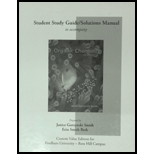
Concept explainers
(a)
Interpretation: The additional resonance structure for the given ion is to be drawn.
Concept introduction: Most of the organic structures cannot be represented using single Lewis structure. Therefore, there exists more than one Lewis structure for representing a molecule or ion. These structures are known as resonance structures. These are the hypothetical structures and do not specify the exact structure. These resonance structure combine together to give resonance hybrid that is lower in energy and is the most stable structure.
The delocalization of electrons results in the formation resonance structure.
(b)
Interpretation: The additional resonance structure for the given ion is to be drawn.
Concept introduction: Most of the organic structures cannot be represented using single Lewis structure. Therefore, there exists more than one Lewis structure for representing a molecule or ion. These structures are known as resonance structures. These are the hypothetical structures and do not specify the exact structure. These resonance structure combine together to give resonance hybrid that is lower in energy and is the most stable structure.
The delocalization of electrons results in the formation resonance structure.
(c)
Interpretation: The additional resonance structure for the given ion is to be drawn.
Concept introduction: Most of the organic structures cannot be represented using single Lewis structure. Therefore, there exists more than one Lewis structure for representing a molecule or ion. These structures are known as resonance structures. These are the hypothetical structures and do not specify the exact structure. These resonance structure combine together to give resonance hybrid that is lower in energy and is the most stable structure.
The delocalization of electrons results in the formation resonance structure.
(d)
Interpretation: The additional resonance structure for the given ion is to be drawn.
Concept introduction: Most of the organic structures cannot be represented using single Lewis structure. Therefore, there exists more than one Lewis structure for representing a molecule or ion. These structures are known as resonance structures. These are the hypothetical structures and do not specify the exact structure. These resonance structure combine together to give resonance hybrid that is lower in energy and is the most stable structure.
The delocalization of electrons results in the formation resonance structure.
Want to see the full answer?
Check out a sample textbook solution
Chapter 16 Solutions
Organic Chemistry -Study Guide / Solution Manual (Custom)
- 7.42 Draw resonance structure for (a) (b) and (c)arrow_forwardDraw a second resonance structure for each species in parts (a), (b), and (c). Draw two additional resonance structures for the ion in part (d).arrow_forwardwrite all the resonance structures of a and b, and show the electrons movement with arrows.arrow_forward
- Need help drawing any other resonance structures of A.arrow_forwardWith reference to cation B, label each species as an isomer, a resonance structure, or neither.arrow_forwarda) Draw all reasonable resonance structures for the following molecules. b) Label the major and minor resonance structures. If they are all equal write equal.arrow_forward
- Resonance structure B is a A. major (more important) resonance structure. B. minor (less important) resonance structure.arrow_forwardDraw at least 10 more resonance structures for acetaminophen, theactive pain reliever in Tylenol. (file Attached)arrow_forwardConsidering the structure on the far left as the original resonance structure, which of the subsequent resonance structures (A-D) is implausible. Explain why you believe the resonance structure to be implausible.arrow_forward
- Draw additional resonance structures for each ion.arrow_forwardThis is an organic chem question. draw 2 additional resonance structures for each part a and barrow_forwardConsider compounds A–D, which contain both a heteroatom and a double bond. (a) For which compounds are no additional Lewis structures possible? (b) When two or more Lewis structures can be drawn, draw all additional resonance structures.arrow_forward
 Chemistry for Engineering StudentsChemistryISBN:9781337398909Author:Lawrence S. Brown, Tom HolmePublisher:Cengage LearningChemistry: Matter and ChangeChemistryISBN:9780078746376Author:Dinah Zike, Laurel Dingrando, Nicholas Hainen, Cheryl WistromPublisher:Glencoe/McGraw-Hill School Pub Co
Chemistry for Engineering StudentsChemistryISBN:9781337398909Author:Lawrence S. Brown, Tom HolmePublisher:Cengage LearningChemistry: Matter and ChangeChemistryISBN:9780078746376Author:Dinah Zike, Laurel Dingrando, Nicholas Hainen, Cheryl WistromPublisher:Glencoe/McGraw-Hill School Pub Co Chemistry by OpenStax (2015-05-04)ChemistryISBN:9781938168390Author:Klaus Theopold, Richard H Langley, Paul Flowers, William R. Robinson, Mark BlaserPublisher:OpenStax
Chemistry by OpenStax (2015-05-04)ChemistryISBN:9781938168390Author:Klaus Theopold, Richard H Langley, Paul Flowers, William R. Robinson, Mark BlaserPublisher:OpenStax Organic Chemistry: A Guided InquiryChemistryISBN:9780618974122Author:Andrei StraumanisPublisher:Cengage Learning
Organic Chemistry: A Guided InquiryChemistryISBN:9780618974122Author:Andrei StraumanisPublisher:Cengage Learning Introductory Chemistry: An Active Learning Approa...ChemistryISBN:9781305079250Author:Mark S. Cracolice, Ed PetersPublisher:Cengage Learning
Introductory Chemistry: An Active Learning Approa...ChemistryISBN:9781305079250Author:Mark S. Cracolice, Ed PetersPublisher:Cengage Learning




